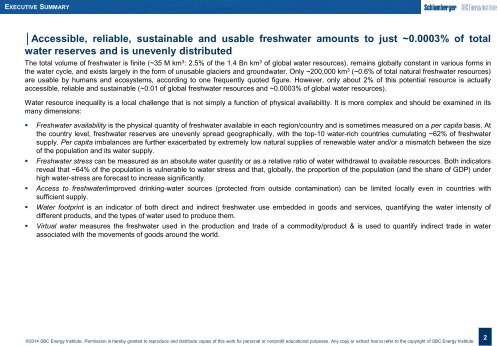1wMF53w
1wMF53w
1wMF53w
Create successful ePaper yourself
Turn your PDF publications into a flip-book with our unique Google optimized e-Paper software.
EXECUTIVE SUMMARY<br />
│Accessible, reliable, sustainable and usable freshwater amounts to just ~0.0003% of total<br />
water reserves and is unevenly distributed<br />
The total volume of freshwater is finite (~35 M km 3 : 2.5% of the 1.4 Bn km 3 of global water resources), remains globally constant in various forms in<br />
the water cycle, and exists largely in the form of unusable glaciers and groundwater. Only ~200,000 km 3 (~0.6% of total natural freshwater resources)<br />
are usable by humans and ecosystems, according to one frequently quoted figure. However, only about 2% of this potential resource is actually<br />
accessible, reliable and sustainable (~0.01 of global freshwater resources and ~0.0003% of global water resources).<br />
Water resource inequality is a local challenge that is not simply a function of physical availability. It is more complex and should be examined in its<br />
many dimensions:<br />
• Freshwater availability is the physical quantity of freshwater available in each region/country and is sometimes measured on a per capita basis. At<br />
the country level, freshwater reserves are unevenly spread geographically, with the top-10 water-rich countries cumulating ~62% of freshwater<br />
supply. Per capita imbalances are further exacerbated by extremely low natural supplies of renewable water and/or a mismatch between the size<br />
of the population and its water supply.<br />
• Freshwater stress can be measured as an absolute water quantity or as a relative ratio of water withdrawal to available resources. Both indicators<br />
reveal that ~64% of the population is vulnerable to water stress and that, globally, the proportion of the population (and the share of GDP) under<br />
high water-stress are forecast to increase significantly.<br />
• Access to freshwater/improved drinking-water sources (protected from outside contamination) can be limited locally even in countries with<br />
sufficient supply.<br />
• Water footprint is an indicator of both direct and indirect freshwater use embedded in goods and services, quantifying the water intensity of<br />
different products, and the types of water used to produce them.<br />
• Virtual water measures the freshwater used in the production and trade of a commodity/product & is used to quantify indirect trade in water<br />
associated with the movements of goods around the world.<br />
©2014 SBC Energy Institute. Permission is hereby granted to reproduce and distribute copies of this work for personal or nonprofit educational purposes. Any copy or extract has to refer to the copyright of SBC Energy Institute<br />
2


